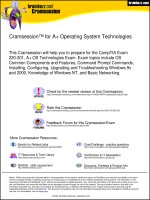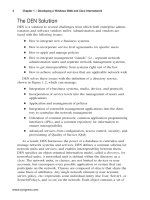Tài liệu Building a RISC System in an FPGA Part 3 doc
Bạn đang xem bản rút gọn của tài liệu. Xem và tải ngay bản đầy đủ của tài liệu tại đây (143.33 KB, 7 trang )
CIRCUIT CELLAR
®
Issue 118 May 2000
1
www.circuitcellar.com
Building a RISC System
in an FPGA
FEATURE
ARTICLE
Jan Gray
t
Now that the xr16
RISC processor is
complete, it’s time to
tie everything to-
gether and wrap up
this series. In this fi-
nal part, Jan designs
a demo system that
includes an on-chip
bus, memory control-
ler, video controller,
and peripherals.
he xr16 RISC
processor is de-
signed, now it’s time
to design the rest of the
System-on-a-Chip (SoC). Besides the
CPU, the FPGA hosts an on-chip bus,
bus controller, parallel port, RAM,
video controller, and an external
SRAM controller.
This month, I’ll show how simple
interfaces can make SoC design as
straightforward as classic CPU, glue
logic, memory, peripherals, and PCB
design used to be.
XS40 BOARD
The project targets the XESS XS40-
005XL V.1.2 FPGA board in Photo 1,
which includes a Xilinx XC4005XL,
12-MHz oscillator (see Figure 1),
32-KB SRAM, 8031 MCU,
7-segment LED, voltage
regulators, and parallel
port and VGA port connec-
tors. It’s simple, inexpen-
sive, and is featured in The
Practical Xilinx Designer
Lab Book included with
Xilinx Student Edition.
I chose this board be-
cause it is well supported
with documentation and
tools, and because it can
be used for both the XSE
exercises and this project.
A SYSTEM-ON-A-CHIP
I’ll build an integrated system from
the resources at hand—the FPGA,
RAM, the video and parallel ports,
and the 12-MHz oscillator.
I used the RAM for program, data,
and video memory. The byte-wide,
asynchronous SRAM isn’t ideal, but it
is fast enough for you to read and
latch a byte on each clock edge,
thereby fetching a 16-bit instruction
during each cycle.
By displaying all 32 KB of RAM,
you can fashion a bitmapped 576 ×
455 monochrome video display at
VGA-compatible sync frequencies.
How quaint, to watch every bit on
screen!
Refer also to Figure 4, the FPGA
top-level schematic. It includes the
Part 3: System-on-a-Chip Design
Table 1
—The system memory map includes eight decoded peripheral
control register address blocks.
Address Resource
0000-7FFF external 32-KB RAM,
video frame buffer
0000 reset handler
0010 interrupt handler
FF00-FFFF I/O control registers,
8 peripherals × 32 bytes
FF00-FF1F 0: 16-word on-chip IRAM
FF21 1: parallel port input byte
FF41 2: parallel port output byte
FF60-FF7F 3:
unused
……
FFE0-FFFF 7:
unused
2
Issue 118 May 2000 CIRCUIT CELLAR
®
www.circuitcellar.com
processor (P), the system memory/bus
controller (MEMCTRL), the on-chip
16-bit data bus (D
15:0
), on-chip periph-
erals (PARIN, PAROUT, and IRAM),
the external SRAM interface, and the
VGA video controller.
DECISIONS, DECISIONS
Before examining the design, let’s
briefly explore the on-chip bus design
space. (This is not the sort of thing
you worry about when designing to
someone else’s microprocessor, but in
an FPGA SoC, you have a little more
freedom.)
Bus design issues include how
many bus masters are permitted, how
is the bus clocked and pipelined, how
wide is it, does it provide byte ad-
dressing, and is it split or unified with
the processor core RESULT bus.
For XSOC, the pipelined on-chip
16-bit data bus D
15:0
is single-mas-
tered (but recall the CPU also per-
forms DMA transfers), the bus clock
is the CPU clock, and the on-chip
data bus is unified with the pro-
cessor’s RESULT
15:0
data bus. All of
these design decisions help to keep
this project simple.
BUS CONTROLS
MEMCTRL, the system bus/
memory controller, interfaces the
processor to the on-chip and off-chip
peripherals. It receives the pipelined
“next transaction” memory request
signals AN
15:0
, WORDN, READN,
DBUSN, and ACE from the CPU.
Then, it decodes the address, enables
some peripheral or memory, and later
asserts RDY in the clock cycle in
which the memory cycle completes.
I/O registers are memory mapped (see
Table 1).
There are eight transaction types:
(external RAM or I/O) × (read or
write) × (byte or word), all decoded
from AN
15:0
, WORDN, and READN.
MEMCTRL manages transfers on
the on-chip data bus D
15:0
and the
external data bus XD
7:0
by asserting
various tri-state output enables (xT)
and control register clock enables
(xCE). These enable signals are as-
serted according to the transaction
type (see Table 3).
For example, during swr0,
0xFF00, MEMCTRL decodes an I/O
write word request. It asserts LDT
and UDT, driving the store data onto
D
15:0
, and asserts IRAM/LCE and
IRAM/UCE, writing D
15:0
into IRAM’s
SRAMs:
IRAM/D
15:0
:= D
15:0
← DOUT
15:0
Next, consider a store to external
RAM: swr0,0x0100. Because the
external data bus is only eight bits
wide, first store the least significant
byte, then the most significant byte.
First, MEMCTRL asserts LDT and
XDOUTT:
XD
7:0
¬ D
7:0
¬ DOUT
7:0
Later, it asserts UDLDT and
XDOUTT:
XD
7:0
← D
7:0
← DOUT
15:8
BUS INTERFACE
Now, let’s design an on-chip bus
peripheral interface to enable robust
and easy reuse of peripheral cores and
to prepare for an ecology of interoper-
able cores to come.
It helps to distinguish between
core users and core designers. The
former are more numerous, while the
latter are more experienced. There-
fore, I make ease-of-use tradeoffs in
favor of core users.
Because FPGAs are malleable and
FPGA SoC design is so new, I wanted
an interface that can evolve to address
new requirements without invalidat-
ing existing designs.
With these two considerations in
mind, I borrowed a few ideas from the
software world and defined an ab-
stract control signal bus with all of
the common control signals collected
into an opaque bus CTRL
15:0
.
MEMCTRL drives CTRL and also
does I/O address decoding, driving the
eight I/O selects SEL
7:0
.
Now, you need only instantiate the
core, attach CLK, CTRL, D, some
SEL
i
, any core-specific inputs and
outputs, and you’re done!
Contrast this with interfacing to a
traditional peripheral IC. Each IC has
its own idiosyncratic set of control
signals, I/O register addresses, chip
selects, byte read and write strobes,
ready, interrupt request, and such.
They don’t call it glue logic for nothing.
Of course, we can’t just sweep all
the complexity under the rug. Each
core must decode CTRL and recover
the relevant control signals. This is
done with the DCTRL (CTRL de-
coder) macro (see Figure 5). DCTRL
inputs SEL
i
, CTRL
15:0
, and CLK and
outputs local I/O register address,
upper and lower byte output enables
(read strobes), and clock enables
(write strobes).
Within each DCTRL instance, you
do final address decoding for the spe-
cific peripheral, combining its SEL
i
signal with the I/O select within
CTRL
15:0
. Here XIN8 only uses LDT
(the LSB output enable). The other
DCTRL outputs are unloaded and
automatically eliminated by the
FPGA implementation tools.
Using DCTRL and the on-chip tri-
state bus, the typical overhead per
peripheral is only one or two CLBs,
and perhaps a column of TBUFs.
Control signal abstraction can also
make bus interface evolution easy. If
you revise MEMCTRL and DCTRL
together, arbitrary changes to CTRL
15:0
can be made without invalidating any
Figure 1
—The system schematic depicts the subset of
the XS40 needed for our project. The 8031 (not shown)
is held in reset.
Table 2
—There are a set of enables
p/*
within each
peripheral. DOUT
15:0
is the CPU store data output
register (see Part 1,
Circuit Cellar
116).
Enable Effect
LDT D
7:0
← DOUT
7:0
UDT D
15:8
← DOUT
15:8
UDLDT D
7:0
← DOUT
15:8
XDOUTT XD
7:0
← D
7:0
LXDT D
7:0
← XDIN
7:0
UXDT D
15:8
← XDIN
15:8
p/
LDT D
7:0
←
p/
D
7:0
p/
UDT D
15:8
←
p/
D
15:8
p/
LCE
p/
D
7:0
:= D
7:0
p/
UCE
p/
D
15:8
:= D
15:8
CIRCUIT CELLAR
®
Issue 118 May 2000
3
www.circuitcellar.com
Table 3
—Depending on the memory transaction, different bus output
enables and register clock enables are asserted.
Figure 3
—The rest of the device contains the auto-
matically placed processor control unit and other logic.
existing designs. And, to add new bus
features, simply design a new decoder
DCTRL_v2, causing no changes to
existing DCTRL clients.
EXTERNAL I/O INTERFACE?
There isn’t one. If it were necessary
to attach external peripherals, perhaps
to the XD
7:0
bus, you might design
some on-chip external peripheral
adapter macros. Just like an on-chip
peripheral, each adapter would take
CTRL and some SEL
i
, but its job
would be to use additional I/O pins to
control its peripheral IC’s chip selects
and so forth. Of course, as a CTRL
15:0
client, it would be able to raise inter-
rupts, insert wait states, and so forth.
EXTERNAL RAM
The external RAM is a classic
32-KB fast asynchronous SRAM with
a 15-ns access time (t
AA
). Its pins in-
clude A14:0 (address), D7:0 (data in/
out), /CS (chip select), /WE (write
enable), and /OE (output enable).
Refer to Figure 2 and the external
bus and SRAM interface block of
Figure 5.
XA
14:1
is 14 IOBs configured as
OFDXs (output flip-flops with clock
enables). XA
14:1
captures the next ad-
dress AN
14:1
at the start of each new
memory transaction. XA
0
(XA_0) is
the least significant bit of the external
address. It is a logic output and can
change on either CLK edge.
XD
7:0
is eight IOBs configured as
eight sets of simultaneous OBUFTs
(tri-state output buffers), IBUFs (input
buffers), and IFDs (input flip-flops).
During a RAM write, XDOUTT is
asserted, RAMNOE is deasserted, and
the OBUFTs drive D
7:0
out onto XD
7:0
.
During a RAM read, XDOUTT is
deasserted, RAMNOE is asserted, and
the RAM drives its output data onto
XD
7:0
. The data is input through the
IBUFs and latched in the XDIN IFDs
(on each falling CLK edge).
To keep the CPU busy with fresh
new instructions, the system reads
both bytes of a 16-bit word in one
cycle. In the first half cycle, it sets
XA
0
=0, reading the MSB, and latches
it in XDIN. In the second half cycle,
the system sets XA
0
=1, reading the
LSB, and reads it through IBUFs. The
catenation of these two bytes,
XDIN
15:0
, feeds the CPU’s INSN port,
the video controller’s PIX port, and
D
15:0
via the byte-wide tri-state buff-
ers LXD and UXD.
Writes to asynchronous SRAM
require careful design. Let’s see if we
can safely write one byte per clock
cycle. The key constraints are:
• address must be valid before assert-
ing /WE
• data must be valid before deassert-
ing /WE
• /WE must be deasserted briefly
• no adddress/data hold
time after /WE
I required a fully syn-
chronous design to be
able to slow or stop the
clock and was unwilling
to employ any asynchro-
nous delay tricks.
Accomplishing this
requires one half clock to
settle the write address,
one half clock to assert /
WE, and one half clock to deassert it.
Therefore, byte writes take two full
cycles, and word writes take three
(e.g., a word write takes six half
cycles W1–W6):
• W1: assert XA
14:1
, data LSB, XA
0
=1
• W2: assert /WE
• W3: deassert /WE, hold XA and data
• W4: assert data MSB, XA
1
=0
• W5: assert /WE
• W6: deassert /WE, hold XA and data
MEMCTRL DESIGN
I’ve discussed the responsibilities
of MEMCTRL design: address decod-
ing, on-chip bus control, and external
RAM control. Now, let’s review its
implementation (see Figure 6).
In address decoding, if the next
access is a load/store to address FFxx,
the access is to memory-mapped I/O,
and SELIO is asserted. Otherwise, it’s
a RAM access.
Within each peripheral’s DCTRL
instance, its SEL
i
(decoded from AN
7:5
)
and CTRL
SELIO
combine to develop that
peripheral’s output and clock enables.
For bus control, the current state of
the memory transaction finite state
machine determines which controls
are asserted. The CPU asserts ACE
(address clock enable) to request the
next transaction and awaits RDY.
MEMCTRL decodes the request, and
the FSM enters the IO, RAMRD, or
RAMWR state. The latter has three
sub-states—W12, W34, and W56—
corresponding to pairs of the W1–W6
half-states described previously.
In the IO state, RDY is asserted
unless the selected peripheral
deasserts CTRL
0
, the I/O ready line,
thereby inserting a wait state.
In the RAMRD state, RDY is as-
Figure 2
—The RAM interface signals for three memory
transactions are: read 1234 from address 0010, write
ABCD to address 0200, and read 5678 from address
0012.
CLK
Read
W1 W2 W3 W4 W5 W6
Read
XA[14:1]
0010
0200
0012
XA_0
12 34
CD
AB
56
78
XD[7:0]
/WE
/OE
Transaction Cycles Enables
RAM read byte 1 LXDT
RAM read word 1 LXDT, UXDT
RAM write byte 2 LDT, XDOUTT
RAM write word 3 LDT or UDLDT, XDOUTT
I/O read byte 1+
p/
LDT
I/O read word 1+
p/
LDT,
p/
UDT
I/O write byte 1+ LDT,
p/
LCE
I/O write word 1+ LDT, UDT
p/
LCE,
p/
UCE
PMUX, P
PIXELS, LXD, UXD
AREGS, AREG, SLUBUF
BREGS, BREG, SRBUF
FWD, A, UDLDBUF, ZHBUF
IMMED, B, LDBUF, UDBUF
LOGIC, D
OUT
,LOGICBUF
ADDSUB, SUMBUF
PCDISP, Z
ADDRMUX
PCINCR
PC, RET, RETBUF
IRAM
RNA
CPU CTRL, SYSCTRL, MISC
RNB
RNA
4
Issue 118 May 2000 CIRCUIT CELLAR
®
www.circuitcellar.com
Figure 5—
The XIN8 (PARIN) implementation shows the CTRL
decoder output LDT that enables the input byte to be driven onto the
data bus.
serted immediately because all
RAM reads require only one
clock cycle. In the RAMWR
state, RDY is asserted on W34 for
byte stores and on W56 for word
stores.
The write controller uses flip-
flops W23_45 and W45, which are
clocked on CLK falling edges. So,
W34 is true during W3 and W4, while
W45 is true during W4 and W5. From
the W* signals you derive glitch-free
control signals XA_0, /WE, /OE, and so
on.
The rest of MEMCTRL is straight-
forward. Note how E encodes (re-
names) the various peripheral control
signals to CTRL
15:0
.
I technology-mapped some logic
using FMAPs. Timing analysis had
revealed poor automatic mapping of
this logic. This change shaved a few
nanoseconds off the critical path.
Now that we’ve covered the imple-
mentation of MEMCTRL, let’s turn
our attention to peripherals.
PARALLEL PORT I/O
I provided parallel port I/O to com-
municate with the host. The XS40
board provides eight parallel port data
inputs and five status outputs. Reserv-
ing a few for debug I/Os, I used six
inputs and four outputs.
During lb rd,FF41, the PARIN
input peripheral is selected, driving
the inputs 00 || PAR_D
5:0
onto D
7:0
(see
Figure 5).
During sb r1,FF21, the PAROUT
output peripheral is selected, captur-
ing the store data D
3:0
in flip-flops,
which drive the PC_S
6:3
status outputs.
XOUT4 is as simple as XIN8. It
has a DCTRL decoder, of course, and
clocks D
3:0
on LCE (LSB clock enable).
This parallel port requires only three
CLBs, eight TBUFs, and 10 IOBs!
ON-CHIP RAM
XSOC also includes a 16 × 16-bit
RAM peripheral. It uses all of the
DCTRL outputs: A
4:1
to select the
word to read or write, LCE and UCE
as lower and upper byte write strobes,
and LDT and UDT as lower and upper
byte output enables.
VIDEO CONTROLLER
The bit-mapped video controller,
based on ideas from [1], displays all
32 KB of external SRAM at 576 × 455
resolution, monochrome.
It runs autonomously from the
CPU, and so is not a peripheral on the
on-chip bus. It uses DMA to fetch
video data, which consumes about
10% of memory bandwidth.
A video signal is a series of frames;
each frame is a series of lines, and
each line is a series of pixels. The
video controller fetches 16-pixel words
of video memory, shifts the pixels out
serially, and uses horizontal and verti-
cal sync pulses to format the pixels
into frames and lines for the monitor.
Generating VGA-compatible hori-
zontal and vertical sync timings, VGA
shifts pixels out at 24
MHz, twice the sys-
tem clock rate, shift-
ing one out when CLK
is high and a second
when it is low. The
horizontal and vertical
sync pulses are ad-
vanced a few clocks
(lines) to center the
display in the frame
(see Table 5).
The VGA ports are
described in Table 6.
The first five ports
Photo 1
—Here’s the XS40 board, with the project design loaded into the
FPGA and running a demo program that’s drawing graphics on the monitor.
request new pixel data via the
DMA controller. The rest are the
VGA video outputs. The red,
green, and blue intensities R1,
R0, G1, G0, B1, and B0 drive
resistor-based 2-bit D/A convert-
ers, providing up to 64 colors (4 ×
4 × 4). However, at this resolu-
tion, with 32 KB of RAM, you
can only support a monochrome (1-
bit/pixel) display. So, each pixel bit
drives all six outputs, drawing black
or white pixels.
To generate horizontal and vertical
syncs and a video blanking signal, you
need a 9-bit horizontal cycle counter
and a 10-bit vertical line counter.
After 288 clocks, it’s time to blank
the video. Assert horizontal sync after
308 clocks, deassert it after 353, and
reset the counter and re-enable video
after 381 clocks (one line).
In the vertical direction, the VGA
controller must blank video after 455
lines, assert vertical sync after 486
lines, deassert it after 488 lines, and
reset the counter, re-enable video, and
reset the video DMA address counter
after 528 lines.
The simplest way to build each
counter is with a Xilinx library binary
counter, such as a CC16RE. But be-
cause I had just about filled the
FPGA, and because they’re cool, I
designed a more compact 10-bit linear
feedback shift register (LFSR) counter.
This uses a 10-bit serial shift register
which has an input that is the XOR of
certain shift register output taps.
An n-bit LFSR repeats every 2
n
-1
cycles, but you can make an arbitrary
m-cycle counter by complementing
the LFSR input bit, thereby short-
circuiting the full sequence when a
particular bit pattern is recognized.
My LFSR counter design program can
be downloaded from the Circuit Cel-
lar web site.
Referring to Figure 7, note the
video controller contains two LFSR
counters, H and V. Each has four com-
parators to compare the LFSR bit
patterns to the count patterns output
by my program.
Each of the J-K flip-flops HENN,
NHSYNC, VEN, and NVSYNC are set
on reaching one counter value and
reset on reaching another.
CIRCUIT CELLAR
®
Issue 118 May 2000
5
www.circuitcellar.com
design using the Xilinx tools and
tested it on my XS40 board. Using a
parallel port output for CLK, I wrote
shell scripts to single-step the proces-
sor and observe PC
7:1
on the LEDs.
Later, I ran the CPU at up to 20 MHz.
Starting from a core set of working
instructions, it was easy to test the
rest, one at a time. If something went
awry, I could do a binary search for
the problem, insert a stop: goto
stop; breakpoint into my test,
recompile, and download. A real re-
mote debugger would be nice!
Armed with a working CPU, it is
easy to add and test new features, one
by one. I added double-cycled reads
from external
RAM, then
MEMCTRL, then
LED output regis-
ters. Writing text
messages to the
seven-segment LED
was a big mile-
stone. RAM writes
were next. And,
late in the project I
added DMA, the
video controller,
and interrupts.
I want to em-
phasize the impor-
tance of thorough
testing. You have
your work cut out
for you when prop-
erly testing a
pipelined processor
and an SoC.
This has been a
proof-of-concept
project, and I have
focused on design issues. To ship
something like this, you would need
to budget as much or more time for
validation as for the design and imple-
mentation.
The final system floorplan, as
placed on our 14 × 14 CLB FPGA, is
shown in Figure 3.
SERIES WRAP-UP
In this three-part series, I have
presented the complete design and
implementation of a real, full-fea-
tured, pipelined microprocessor and
an integrated System-on-a-Chip. I
designed a new instruction set, ported
a C compiler, and discussed how to
NHSYNC is asserted low during
clocks 308–353, and NVSYNC during
lines 486–488. HEN is the pipelined
horizontal video enable, and VEN is
the vertical video enable. When both
are true, you fetch and shift out video
data.
In the video datapath, each clock
shifts out two bits of video data. Ev-
ery eight clocks, WORD goes true,
and it requests a new 16-bit word of
video data from memory. REQ is
asserted, registering a pending DMA
transfer with the CPU.
Five or fewer clocks later, the CPU
performs the DMA load, asserting
ACK. The video data word is latched
in the PIXELS staging register. On the
eighth clock, this word is loaded into
the PMUX 8 × 2 parallel-load serial-
out shift register.
Two bits shift out of PMUX during
each clock, and feed a 2–1 mux that
drives the 1-bit pixel each half clock.
SYSTEM BRING-UP
After designing the CPU, I de-
signed a simple test-fixture using on-
chip ROM and ran my test programs
in the Foundation simulator.
After simulating test programs for
hundreds of cycles, I compiled the
Figure 4—
The processor (P) issues requests to MEMCTRL, accessing instruction and data via the on-chip bus D
15:0
or external SRAM.
Integrated peripherals provide parallel port I/O and on-chip RAM. The VGA controller fetches pixel data via DMA.
Tables 5 & 6
—The 12-MHz clock and 24-MHz pixel shift frequency determines the pixels per line and lines per
frame, as well as the horizontal and vertical counter values for sync and blanking events.
Port Description
PIX
15:0
next 16-bit pixel word
REQ request DMA of next word
RESET reset DMA address counter
ACK DMA acknowledge input
CLK system clock
R1,R0 2-bit red intensity
G1,G0 2-bit green intensity
B1,B0 2-bit blue intensity
NHSYNC active-low horizontal sync
NVSYNC active-low vertical sync
Quantity Value
two-pixel clock 83.3 ns
one-pixel half-clock 41.7 ns
visible pixels/line 576
visible clocks/line 288
horizontal sync “on” clock 308
horizontal sync “off” clock 353
line total clocks 381
line time 31.8 ms
visible lines/frame 455
vertical sync “on” line 486
vertical sync “off” line 488
frame total lines 528
frame time 16.8 ms
6
Issue 118 May 2000 CIRCUIT CELLAR
®
www.circuitcellar.com
Figure 7—
As you can see, the video controller contains two LFSR counters that each have four comparators for comparing the LFSR bit patterns to the count patterns that are
output by the program that I wrote.
Figure 6—
The memory
controller consists of an
address decoder, a memory
transaction state machine,
and miscellaneous on-chip
bus and external RAM
control logic.
CIRCUIT CELLAR
®
Issue 118 May 2000
7
www.circuitcellar.com
SOFTWARE
You may download more informa-
tion, including specifications,
source code, schematics, and links
to related sites from the Circuit
Cellar web site.
REFERENCE
[1] VGA Signal Generation with
the XS Board, XESS App Note
www.xess.com/fpga/vga.pdf
SOURCES
XESS XS40-005XL
www.xess.com/fpga
FPGAs, Student Edition tools
Xilinx, Inc.
(408) 559-7778
Fax: (408) 559-7114
www.xilinx.com
Jan Gray is a software developer
whose products include a leading C++
compiler. He has been building FPGA
processors and systems since 1994,
and he now designs for Gray Re-
search LLC. You may reach him at
Please note that I do not warrant
that you have the right to build
something based upon the ideas dis-
cussed in this series of articles under
the relevent intellectual property
laws in your jurisdiction.
© Circuit Cellar, The Magazine for Computer Applications.
Reprinted with permission. For subscription information call
(860) 875-2199, email or on our
web site at www.circuitcellar.com.









